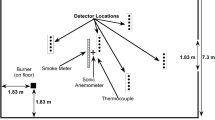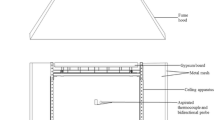Abstract
Simple tools for the design application of smoke detectors in commercial spaces with high ceilings and/or complex geometries do not exist due to the complexity in accurately estimating smoke densities and smoke detector activation characteristics. The response of commercial smoke detectors to UL/ULC standard flaming acceptance test fires and non-standard test fires in large open spaces with ceiling heights varying from 3 m to 21 m with radial distances from the fires up to 11.4 m is measured. Two algebraic models intended for unconfined ceilings, the two-zone computer model CFAST and the computational fluid dynamics computer model FDS are compared against each other and the experimental results. The ability to predict obscuration levels and detection times for these fires is evaluated. Recommendations are made for using the various models in commercial applications.











Similar content being viewed by others
Abbreviations
- \( \dot{m} \) :
-
Mass loss rate [kg/s]
- Cs :
-
Concentration of smoke [g/m3]
- H:
-
Room height [m]
- ∆H:
-
Heat of combustion [kJ/kg]
- I:
-
Intensity of light
- l:
-
Beam length (m)
- m:
-
Mass [kg]
- OD:
-
Optical density [m−1]
- P:
-
Pressure [Pa]
- \( \dot{Q} \) :
-
Heat release rate [kW]
- r:
-
Radius of interest from plume centreline [m]
- S:
-
Smoke [m2]
- t:
-
Time [s]
- T:
-
Temperature [0C]
- V:
-
Volume [m3]
- Ysmoke :
-
Mass yield fraction of smoke [g/g]
- z:
-
Height of interest above fuel [m]
- zo :
-
Virtual origin [m]
- α:
-
Extinction coefficient [m−1]
- αm :
-
Mass specific extinction coefficient [m2/g]
- ϕ:
-
Mass specific absorption area [m2/g]
- σ:
-
Extinction area [m2]
- σm :
-
Mass specific extinction area [m2/g]
- λ:
-
Per cent obscuration of light per meter [%/m]
- ρ:
-
Density [kg/m3]
- χr :
-
Radiative fraction
- c:
-
Convective
- i:
-
Interface
- l:
-
Lower layer, target location
- m:
-
Maximum, mass specific
- o:
-
Origin
- s:
-
Soot or smoke
- g:
-
Gravitational acceleration [9.81 m/s2]
- cp :
-
Specific heat of air at constant pressure [1.004 kJ/kg°C]
References
Shifiliti PP, Meacham BJ, Custer RLP (2002) Design of detection systems. In: SFPE handbook of fire protection engineering, 3rd edn, Sect 4, Chap 1, National Fire Protection Association, Quincy, MA
CAN/ULC-S524-06 Standard for the installation of fire alarm systems, 5th edn
NFPA 72 (2002) National fire alarm code, 2002 Editon
Cholin JM, Marrion C (2001) Performance metrics for fire detection. Fire Prot Eng (11, Summer) 21–30
Pucci WE (2000) Modeling spot type smoke detector response. Fire Prot Eng (7):36–42
Heskestad GJ, Delichatsios MA (1977) Environments of fire detectors, phase I: effects of fire size, ceiling heights, and material, volume II—analysis technical report serial no. 11427, RC-T-11, Factory Mutual Research Corp., Norwood, MA
Notarianni KA, WD Davis (1993) The use of computer models to predict temperature and smoke movement in high Bay spaces. NISTIR 5304, National institute of standards and technology, Gaithersburg MA, December 1993
Davis WD, Forney BP, Bukowski RW (1997) Developing detector siting rules from computational experiments in spaces with complex geometries. In: Luck H (ed) International Conference on Automatic Fire Detection. University of Duisburgm AUBE '95", 10th. April 4–6, 1995, Duisburg, Germany, Fire Safety J 29:129–139
Heskestad G (1971) Report serial no. 21017. Factory Mutual Research Corp., Norwood, MA
Davies WD, Thomas C, Michelle D, Samuel H (2003) Prediction smoke and carbon monoxide detector response in the ceiling jet in the presence of a smoke layer, NISTIR 6976. National Institute of Standards and Technology, July 2003
Thomas C, Artur C, William G, Anderson M (1999) Particle entry lag in spot-type smoke detectors fire safety science. In: Proceedings of 6th international symposium, International Association for Fire Safety Science, July 1999
Bukowski RW, Averill JD (1998) Methods for predicting smoke detector activation. In: Proceedings of fire suppression and detection research application symposium, Research and practice: bridging the gap, February 1998
Roby et al (2007) A smoke detector algorithm for large eddy simulation modeling, NIST GCR 07-911, National Institute of Standards and Technology, July 2007
Watanabe J, Tanaka T (2005) Prediction of ceiling jet smoke concentration under two layer environment. Fire Sci Technol 24(3):151–164
Fabian TZ, Gandhi PD (2007) Smoke characterization project. The Fire Protection Research Foundation, Quincy MA, April 2007
Davis WD, Paul R (2000) Predicting smoke concentration in the ceiling jet, NISTIR 6480. National Institute of Standards and Technology, Gaithersburg, MD, May 2000
CAN/ULC-S529 (2000) Standard for smoke detectors for fire alarm systems, 1st edn. Amended June 2000
ANSI/UL 268-2006 (2006) Standard for smoke detectors for fire alarm signaling systems, 5th edn. Sept 2006
Jones WW, Peacock RD, Forney GP, Reneke PA (2005) CFAST—consolidated model of fire growth and smoke transport (version 6)—technical reference guide. NIST Special Publication 1026, National Institute of Standards and Technology
Peacock RD, Jones WW, Reneke PA, Forney GP (2005) CFAST—consolidated model of fire growth and smoke transport (version 6)—user’s guide. NIST Special Publication 1041, National Institute of Standards and Technology
McGrattan K, Hostikka S, Floyd J, Baum H, Rehm R (2007) Fire dynamics simulator (version 5) technical reference guide. NIST Special Publication 1018-5, National Institute of Standards and Technology
McGrattan K, Klein B, Hostikka S, Floyd J Fire (2007) Dynamics simulator (version 5) user’s guide. NIST Special Publication 1019-5, National Institute of Standards and Technology
Kuffner W, Hadjisophocleous G (2009) Method of determining smoke detector spacing in high ceiling applications. A thesis submitted to the Faculty of Graduate and Research in partial fulfillment of the requirements for the degree Master of Applied Science, Carleton University.
Mullholland GW, Croarkin C (2007) Specific extinction coefficient of flame generated smoke. Fire Mater Fire Mater 24(5):227–230
Seader JD, Einhorn IN (1976) 16th international symposium on combustion, Combustion Institute, Pittsburgh, PA
ASTM E1354 Standard test method for heat and visible smoke release rates for material and products using an oxygen consumption calorimeter
Drysdale D (1998) An introduction to fire dynamics, 2nd edn. Wiley, New York, pp 120–125
Heskestad G (2002) Fire plumes, flame height, and air entrainment. In: SFPE handbook of fire protection engineering, 3rd edn, Sect 2, Chap 1, National Fire Protection Association, Quincy, MA
Iqbal N, Salley MH (2004) Analysis methods for the US nuclear regulatory commission fire protection inspection program. U.S. Nuclear gulatory Commission, Washington DC
Najafi B, Joglar F, Dreisbach J (2007) Verification and validation of selected fire models for nuclear power plant applications. U.S. Nuclear Regulatory Commission and Electrical Power Research Institute, May 2007
Alpert RL (1972) Calculation of response time of ceiling-mounted fire detectors. Fire Technol 8:181–195
Heskestad G, Delichatsios MA (1978) The initial convective flow in fire. In: 17th international symposium on combustion, Combustion Institute, Pittsburgh, PA
Yamauchi Y, Mammoto A, Dohi M, Ebata H, Morita M (2005) A calculation method for predicting heat and smoke detector’s response. Fire Sci Technol 24(4):179–210
Alpert RL (2002) Ceiling jet flows. In: SFPE handbook of fire protection engineering, 3rd edn, Sect 2, Chap 2, Society of Fire Protection Engineers
Author information
Authors and Affiliations
Corresponding author
Rights and permissions
About this article
Cite this article
Kuffner, W., Hadjisophocleous, G. Method of Determining Smoke Detector Spacing in High Ceiling Applications. Fire Technol 50, 723–744 (2014). https://doi.org/10.1007/s10694-010-0141-5
Received:
Accepted:
Published:
Issue Date:
DOI: https://doi.org/10.1007/s10694-010-0141-5




